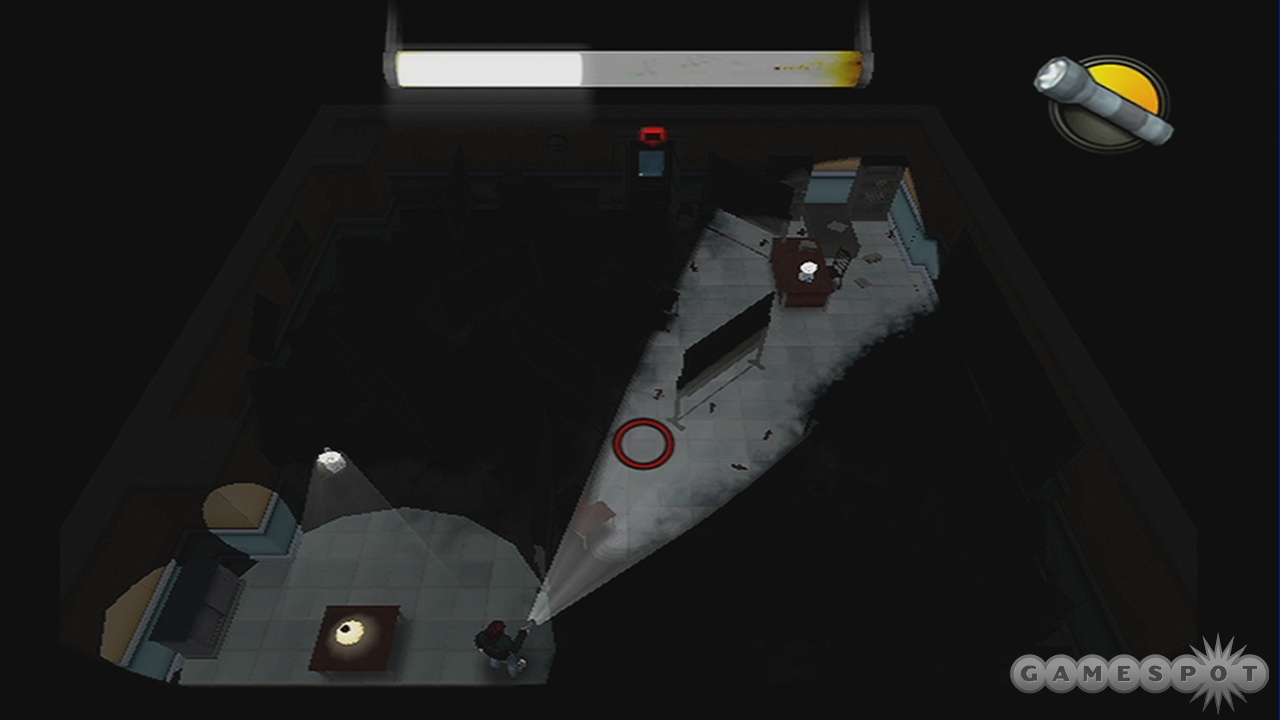Lit is a game that will make you terrified of the dark. This is not because of the ill-defined monsters that lurk just out of sight, or the emo-looking protagonist who seems like he would be right at home when the lights are dimmed. No, the fear of the dark comes from the light-based puzzles that halt your path to freedom. Although Lit looks like a simple puzzle game, its maddeningly clever conundrums will cause you to groan with disappointment while your hero screams with the fear of being captured again. But the solutions to the logical puzzles are always just out of reach, making you try once more to light your path to freedom. At only 800 Wii Points ($8), Lit offers a deep, rewarding experience, and it's one of the most interesting offerings for the WiiWare service.

You play as Jake, a young boy trapped in a haunted schoolhouse, desperately trying to not only make it out alive, but also save his girlfriend Rachel from the clutches of evil. The story does not delve any deeper than it needs to set up this tale, but it does provide some silly nods as you move through the classrooms. Amid the shadowed desks and flickering passageways, a phone will sometimes appear. You can hold the Wii Remote up to your ear to answer it and listen to the desperate cries of Rachel lost somewhere within the building. Her cracks about how this feels like a horror B-movie echo the feeling that this is a low-budget game. Thankfully, the low production values don't get in the way of your quest to find the light.
Lit is broken up into 30 levels, each a solitary classroom within a school. Your goal is deceptively simple: get to the door at the end of each room. The rooms are initially draped in darkness save for a small sliver of light emanating from the entrance, and even a slight step into the darkness will result in a quick death. You are equipped with a flashlight, which can temporarily illuminate objects around you, but you'll have to find a way to light a permanent path to make it to the exit door. Although the initial levels serve as basic tutorials that teach you what does and does not result in your immediate death, the difficulty quickly ramps up, leaving you to figure how to harness the lamps and windows that you'll need to succeed.
There are a few helpful objects lying around the darkened rooms that you'll need to take full advantage of to move on. The slingshot, for which you'll pick up one stone at a time, can be used to crack windows and set off motion sensors. A broken window will let loose a stream of light into the room, letting you walk across it without fear of death. A cherry bomb can also destroy window panes, but the resulting explosion can shatter nearby electronics as well. The collateral damage can be used to skillfully open two windows at once, but it can also halt your progress if you destroy something important. You can also snap a flare to create a momentary halo of safety on the ground. Finally, some rooms have a TV remote, which turns television monitors on and off, providing a small pool of light that you can stand in freely. Aside from these tools, you are given various lamps that must be manually flicked on and off.
Getting through levels can be painstaking, but success is always rewarding. You'll have to seamlessly combine the various light sources to create a cohesive path that will get you to the exit. However, the amount of electricity that you can use is limited, so you'll have to carefully manage how many lamps and televisions are turned on lest you blow out a fuse. Every few levels, you'll face off against a boss character that, in complete contrast to you, is damaged by the light. These fights are intense and nerve-wracking. Most normal levels can be completed as slowly as you desire, but the boss fights demand careful planning and quick movement, which leads to many deaths before you figure out the perfect method of extermination.

Although the majority of levels are tightly constructed and offer only one logical path to freedom, some problems surface from time to time. Most glaring is your finicky relationship with the dark. If you step off of your path, you die--most of the time. In some cases, you are forced to step slightly off of the path to flick a switch or grab some ammo; at other times, you will have to cross a sliver of darkness that separates two pools of light. These situations are infrequent, but you'll have to risk death to test the limits of how far you can walk into the darkness. The other problem that will result in many unplanned deaths is the tricky context-sensitive commands that you dole out with the A button. This do-everything button will grab objects, turn lights on and off, and use whatever you have currently equipped, depending on where you are standing in the room. Given that one button is in charge of every action, you'll find yourself mistakenly pulling off the wrong action, such as turning off an important lamp instead of flicking on a nearby television.
Lit is a dark, difficult game, but the logical nature of the puzzles makes it very rewarding and well worth the cheap entry fee. However, even in this simplistic world, there are a number of problems that will lead to more than a few cheap deaths. Nevertheless, it is worth looking past the design inconsistencies; a few unfortunate deaths are not enough to detract from the rest of this package. Lit is a satisfying journey through the dark and one of the most enjoyable games on the WiiWare service.